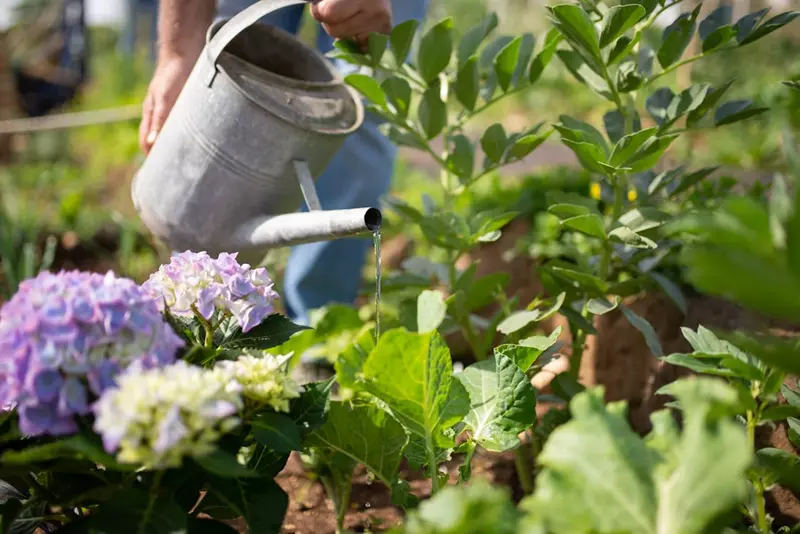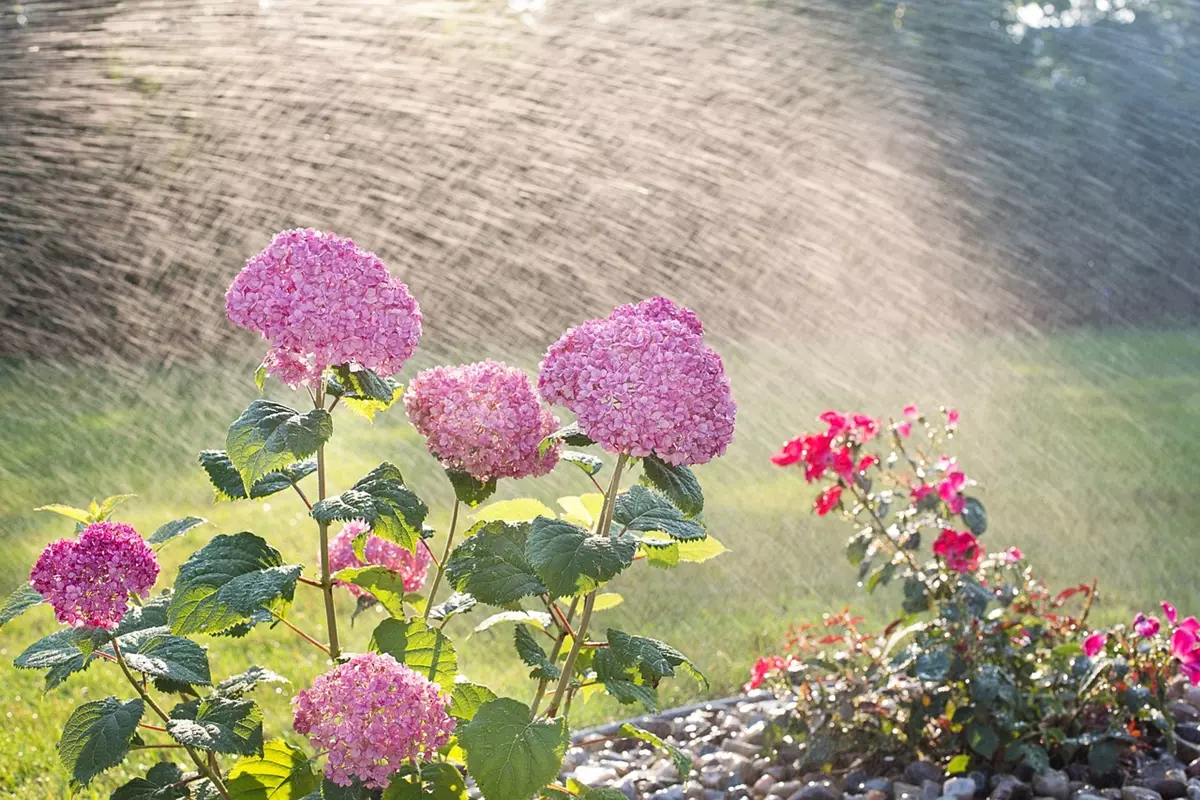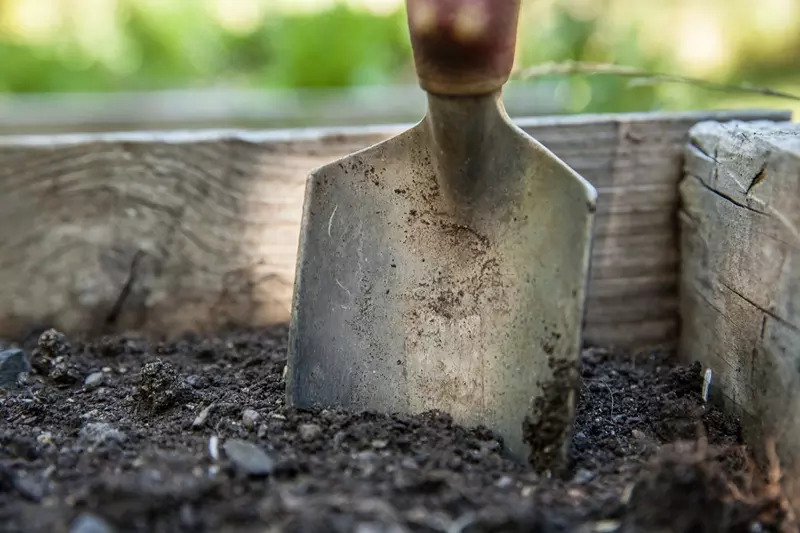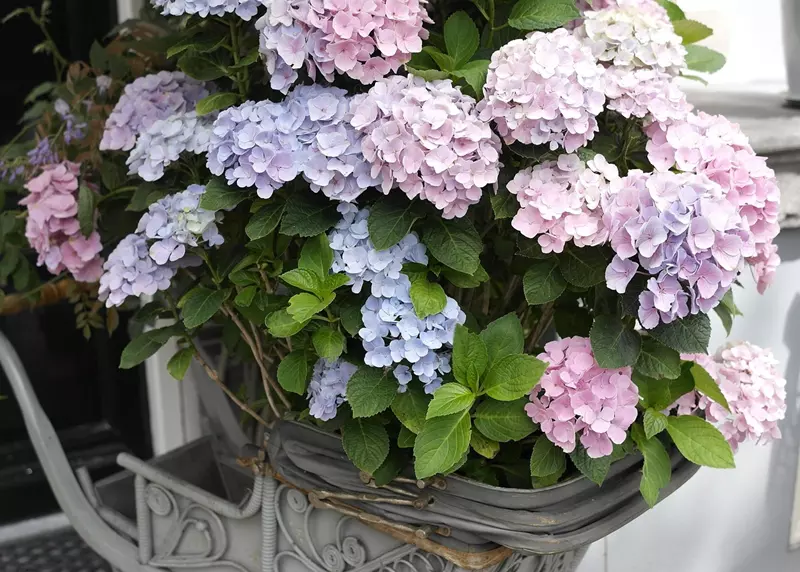Table of Contents
Proper watering is crucial for the health and beauty of your hydrangeas. This guide provides comprehensive advice to ensure your plants flourish.
 Source: pexels.com; Author: Kampus Production; License: Pexels License
Source: pexels.com; Author: Kampus Production; License: Pexels License
The Importance of Proper Watering
Hydrangeas' Water Requirements
Hydrangeas are known for their high water needs, which is reflected in their name derived from 'hydra,' meaning water. They thrive in consistently moist soil but are susceptible to problems if overwatered or underwatered.
Effects of Underwatering
Insufficient watering can cause:
- Wilting: Leaves and flowers may droop due to lack of moisture.
- Stunted Growth: Limited water availability can hinder the plant's development.
- Reduced Flowering: Drought stress may lead to fewer or smaller blooms.
To prevent these issues, it's recommended to water hydrangeas deeply at least once per week, increasing frequency during hot or dry periods.
Effects of Overwatering
Excessive watering can result in:
- Root Rot: Saturated soil can suffocate roots, leading to decay.
- Yellowing Leaves: Overwatered hydrangeas may exhibit chlorosis due to nutrient deficiencies.
- Wilting Despite Moist Soil: Overwatering can cause cells to become waterlogged, leading to wilting.
To avoid overwatering, ensure soil has good drainage and only water when the top inch feels dry to the touch.
Best Practices for Watering Hydrangeas
- Deep Watering: Water slowly and thoroughly to encourage deep root growth, enhancing drought resistance.
- Morning Watering: Watering in the early morning reduces evaporation and allows plants to absorb moisture before the day's heat.
- Mulching: Apply a 2-3 inch layer of mulch around the base to retain soil moisture and regulate temperature.
- Avoid Overhead Watering: Water at the base to prevent fungal diseases associated with wet foliage.
Soil Considerations
Hydrangeas prefer well-draining soil rich in organic matter. Amending soil with compost can improve its moisture-retention capacity while ensuring excess water drains away, preventing root rot.
Recognising Signs of Water Stress
Regularly inspect hydrangeas for signs of water stress:
- Underwatering: Wilting, dry soil, and browning leaf edges.
- Overwatering: Yellowing leaves, consistently wet soil, and root rot symptoms.
Adjust watering practices promptly if any of these signs are observed to maintain plant health.
Proper watering is essential for hydrangeas to flourish. By understanding their water requirements and monitoring soil moisture levels, you can ensure your hydrangeas remain healthy, producing abundant and vibrant blooms.
 From my experience, hydrangeas thrive best when watered deeply and thoroughly rather than frequently and superficially. The key is to apply water slowly at the base of the plant, allowing it to soak deep into the roots, which helps them become more resilient to drought. It's especially important to water in the morning so that the foliage has time to dry by the end of the day, reducing the risk of fungal diseases. - Source: pixabay.com; Author: Jill Wellington; Licence: Pixabay Content Licence
From my experience, hydrangeas thrive best when watered deeply and thoroughly rather than frequently and superficially. The key is to apply water slowly at the base of the plant, allowing it to soak deep into the roots, which helps them become more resilient to drought. It's especially important to water in the morning so that the foliage has time to dry by the end of the day, reducing the risk of fungal diseases. - Source: pixabay.com; Author: Jill Wellington; Licence: Pixabay Content Licence
How Often to Water Hydrangeas
The frequency of watering depends on several factors, including climate, soil type, and whether the hydrangea is newly planted or established.
General Watering Guidelines
Hydrangeas typically require about 1 inch (2.5 cm) of water per week, either from rainfall or supplemental irrigation. This amount can vary based on factors such as species, soil type, and climate. Consistent moisture is key, but it's essential to avoid waterlogged conditions, as hydrangeas do not like their roots sitting in water, which can lead to root rot.
Factors Influencing Watering Frequency
- Soil Type: Sandy soils drain quickly and may require more frequent watering, while clay soils retain moisture longer but can become compacted. Amending soil with compost can improve its moisture-retention capacity while ensuring excess water drains away.
- Climate and Weather: In hot or dry conditions, hydrangeas may need watering more than once a week. Conversely, in cooler, humid climates, less frequent watering might suffice.
- Plant Maturity: Newly planted hydrangeas require more frequent watering to establish roots, often needing water several times a week. Established plants with deeper root systems can tolerate longer intervals between watering.
Best Practices for Watering
- Deep Watering: Water deeply to encourage roots to grow down into the soil, enhancing drought resistance.
- Morning Watering: Watering in the early morning reduces evaporation and allows plants to absorb moisture before the day's heat.
- Mulching: Apply a 2–3 inch layer of mulch around the base to retain soil moisture and regulate temperature.
- Avoid Overhead Watering: Water at the base to prevent fungal diseases associated with wet foliage.
Recognising Signs of Improper Watering
- Underwatering: Wilting, dry soil, and browning leaf edges indicate a need for more frequent watering.
- Overwatering: Yellowing leaves, consistently wet soil, and root rot symptoms suggest excessive watering.
Adjust watering practices promptly if any of these signs are observed to maintain plant health.
Determining how often to water hydrangeas depends on various factors, including soil type, climate, and plant maturity. By monitoring soil moisture and observing plant health, you can establish a watering routine that promotes healthy growth and vibrant blooms.
Best Watering Techniques
Deep Watering
Hydrangeas benefit from deep watering, which encourages roots to grow deeper into the soil, enhancing drought resistance. To achieve this:
- Method: Use a soaker hose or drip irrigation system to deliver water slowly at the base of the plant. This allows water to penetrate the soil deeply, reaching the root zone.
- Frequency: Water deeply once or twice a week, depending on weather conditions and soil type. Adjust frequency during prolonged dry spells or high temperatures.
To make the most of every drop, it’s essential to water efficiently. A good rule of thumb is to apply water directly to the soil rather than the foliage, as plants absorb moisture through their roots. Overhead watering can lead to unnecessary evaporation and even fungal issues. For best results, allow the top few inches of soil to dry slightly between watering to encourage deeper root growth. The English Garden’s guide to wise watering highlights the importance of watering thoroughly but less frequently, ensuring moisture reaches the root zone rather than just dampening the surface.
Morning Watering
Watering hydrangeas in the early morning offers several benefits:
- Reduced Evaporation: Cooler morning temperatures minimise water loss due to evaporation, ensuring more moisture reaches the roots.
- Foliage Drying: Watering early allows foliage to dry throughout the day, reducing the risk of fungal diseases associated with prolonged leaf wetness.
Mulching
Applying mulch around hydrangeas helps retain soil moisture and regulate temperature:
- Material: Use organic mulches such as leaf mould, well-rotted manure, or compost.
- Application: Spread a 5–7.5 cm (2–3 inch) layer around the base of the plant, keeping it a few centimetres away from the stem to prevent rot.
- Benefits: Mulch conserves moisture, suppresses weeds, and improves soil structure as it decomposes.
Avoid Overhead Watering
Watering hydrangeas at the base rather than overhead is crucial:
- Fungal Diseases: Wet foliage can promote fungal infections. Watering at the base keeps leaves dry, reducing disease risk.
- Efficiency: Directing water to the root zone ensures efficient usage, as water reaches where it's needed most.
Soil Considerations
Hydrangeas prefer well-draining, moisture-retentive soil:
- Soil Type: Amend heavy clay soils with organic matter to improve drainage, and add compost to sandy soils to enhance moisture retention.
- pH Levels: Soil pH can influence flower colour in some hydrangea species. For instance, acidic soils can produce blue flowers, while alkaline soils may result in pink blooms.
Monitoring Soil Moisture
Regularly check soil moisture to determine watering needs:
- Technique: Insert your finger into the soil up to the second knuckle. If it feels dry at this depth, it's time to water.
- Tools: Consider using a soil moisture meter for more accurate readings, especially in large gardens or with multiple hydrangea plants.
Adjusting for Seasonal Changes
Hydrangeas' water needs vary with the seasons:
- Spring and Summer: Increase watering frequency during active growth and blooming periods, particularly during hot, dry spells.
- Autumn and Winter: Reduce watering as plants enter dormancy, but ensure soil doesn't become completely dry, especially in milder climates.
Implementing these watering techniques will help ensure your hydrangeas receive the appropriate moisture for optimal growth and flowering. Regular monitoring and adjusting your watering practices based on environmental conditions will contribute to the long-term health and beauty of your hydrangea plants.
Seasonal Watering Considerations for Hydrangeas
Spring
As temperatures rise and hydrangeas emerge from dormancy, their water needs increase. Consistent moisture is crucial during this growth phase.
- Watering Frequency: Provide deep watering once or twice a week, ensuring the soil remains consistently moist but not waterlogged.
- Soil Preparation: Incorporate organic matter into the soil to improve moisture retention and support new growth.
Summer
The heat of summer can lead to increased evaporation and potential drought stress for hydrangeas. Adjusting watering practices during this period is vital.
- Watering Frequency: Increase watering to two or three times a week, especially during prolonged dry spells or heatwaves.
- Time of Day: Water early in the morning to reduce evaporation and allow plants to absorb moisture before the day's heat intensifies.
- Mulching: Apply a 5–7.5 cm (2–3 inch) layer of mulch around the base to retain soil moisture and regulate temperature.
Autumn
As temperatures cool and rainfall increases, hydrangeas begin to prepare for dormancy. Watering practices should be adjusted accordingly.
- Watering Frequency: Reduce watering to once a week, monitoring soil moisture to prevent overwatering.
- Soil Drainage: Ensure soil drains well to avoid waterlogged conditions, which can lead to root rot during cooler months.
Winter
During winter dormancy, hydrangeas require minimal watering. However, certain considerations are necessary to protect them from cold damage.
- Watering Frequency: In regions with mild winters, water once a month if there is no natural precipitation. In colder climates, additional watering is typically unnecessary.
- Mulching: Maintain mulch around the base to insulate roots and conserve soil moisture.
- Protection: Consider using burlap or frost covers to shield hydrangeas from extreme cold, especially for less hardy varieties.
Additional Tips
- Soil Moisture Monitoring: Regularly check soil moisture levels by inserting your finger into the soil up to the second knuckle. If it feels dry at this depth, it's time to water.
- Planting Location: Position hydrangeas in areas with morning sun and afternoon shade to reduce water stress during hot periods.
- Species Considerations: Different hydrangea species have varying water needs. For instance, Bigleaf hydrangeas prefer more moisture compared to Panicle varieties.
Adapting your watering practices to the seasonal needs of hydrangeas is essential for their health and flowering potential. By understanding and responding to these seasonal variations, you can ensure your hydrangeas remain vibrant and resilient throughout the year.
Watering Hydrangeas in Pots
Understanding Hydrangeas' Water Needs
Hydrangeas are known for their high water requirements, and this need is amplified when they are grown in pots. Unlike garden-planted hydrangeas, containerised plants have limited access to soil moisture, making consistent watering essential.
Choosing the Right Container and Soil
- Container Size: Select a pot that is several inches wider in diameter than the plant's root ball to accommodate growth and moisture retention. Ensure the container has adequate drainage holes to prevent waterlogging.
- Soil Mix: Use a high-quality, soil-based compost such as John Innes No.3, possibly with added multi-purpose compost, to provide necessary nutrients and support moisture retention.
Optimal Watering Techniques
- Watering Method: Water your container-grown hydrangea by filling the pot to the brim, allowing it to drain, and repeating. This ensures thorough hydration of the root system.
- Frequency: During active growth and blooming periods, water frequently to keep the soil consistently moist but not waterlogged. Adjust the frequency based on weather conditions, increasing during hot, dry spells and reducing during cooler, damp periods.
- Time of Day: Watering in the early morning or late afternoon reduces evaporation and allows the plant to absorb moisture effectively.
Monitoring Soil Moisture
Regularly check the soil moisture by inserting your finger into the top inch of the soil. If it feels dry, it's time to water. Be cautious not to let the soil become bone dry, as hydrangeas are sensitive to drought stress.
Seasonal Adjustments
- Spring and Summer: Increase watering frequency during warmer months when the plant is actively growing and blooming. Ensure the soil remains consistently moist, as containers can dry out quickly in the heat.
- Autumn and Winter: Reduce watering as the plant enters dormancy. Keep the soil slightly moist, but avoid overwatering, as reduced evaporation can lead to waterlogged conditions.
Additional Tips
- Mulching: Apply a layer of mulch on top of the soil to help retain moisture and regulate soil temperature.
- Fertilisation: Feed the plant every week while it's blooming, using a water-soluble fertiliser diluted to half strength. After blooming, reduce feeding to once a month.
- Location: Place the pot in a spot that receives full sun in the morning and some shade in the afternoon to prevent the soil from drying out too quickly.
Proper watering is crucial for the health and vitality of potted hydrangeas. By understanding their specific needs and adjusting your care routine accordingly, you can enjoy the beauty of these plants throughout the growing season.
Signs of Overwatering and Underwatering
Overwatering can deprive hydrangea roots of necessary oxygen, leading to several noticeable symptoms:
- Wilting Leaves: Contrary to intuition, overwatered hydrangeas may exhibit wilting leaves due to root suffocation.
- Yellowing Leaves: Excess moisture can cause leaves to turn yellow, indicating stress.
- Leaf Drop: Both old and new leaves may fall off the stems when overwatered.
- Root Rot: Persistent wet conditions can lead to root rot, characterised by brown, mushy roots and a foul odour.
- Stunted Growth: Overwatered hydrangeas may exhibit slow or halted growth due to nutrient uptake issues.
Signs of Underwatering
Insufficient watering can also adversely affect hydrangeas, with symptoms including:
- Drooping Leaves: Lack of water causes leaves to droop as the plant conserves moisture.
- Wilting Leaves and Flowers: Underwatered hydrangeas often display wilting leaves and flowers due to insufficient moisture.
- Yellowing Leaves: Leaves may turn yellow when the plant is deprived of essential nutrients due to lack of water.
- Brown Spots on Leaves: Dry conditions can lead to brown, crispy spots on foliage.
- Leaf Curling: Leaves may curl up as a response to dehydration.
- Dry or Cracked Soil: The soil around the plant may appear dry or cracked, indicating insufficient moisture.
Distinguishing Between Overwatering and Underwatering
While some symptoms overlap, key differences can help identify the issue:
- Soil Moisture: Check the soil's moisture level; soggy soil suggests overwatering, while dry soil points to underwatering.
- Leaf Texture: Overwatered plants may have soft, mushy leaves, whereas underwatered plants typically exhibit dry, crispy foliage.
Preventative Measures
To maintain optimal hydration for hydrangeas:
- Consistent Watering Schedule: Water deeply once or twice a week, adjusting based on rainfall and temperature.
- Well-Draining Soil: Ensure soil has good drainage to prevent waterlogging.
- Mulching: Apply mulch to retain soil moisture and regulate temperature.
- Regular Monitoring: Frequently check soil moisture and plant appearance to detect early signs of stress.
Proper watering is essential for hydrangea health. By recognising and addressing the signs of overwatering and underwatering, you can ensure your plants thrive and continue to enhance your garden with their beauty.
Additional Tips for Healthy Hydrangeas
1. Selecting the Ideal Location
Hydrangeas thrive in locations with morning sun and afternoon shade. Avoid planting them in deep shade or full, intense sunlight, as this can affect blooming and overall health.
2. Soil Preparation and pH Considerations
Hydrangeas prefer moist, well-draining soil enriched with organic matter. Incorporate compost or well-rotted manure to improve soil fertility and structure. Additionally, the pH of the soil can influence the flower colour of certain hydrangea species:
- Acidic Soil (pH below 6): Produces blue flowers.
- Neutral to Alkaline Soil (pH 7 and above): Yields pink or red flowers.
Adjusting soil pH can help achieve desired flower colours.
3. Mulching
Apply a 5–7.5 cm (2–3 inch) layer of organic mulch, such as leaf mould or compost, around the base of the plant. Mulching helps retain soil moisture, regulate temperature, and suppress weeds.
4. Pruning Practices
Pruning hydrangeas varies by species:
- Mophead and Lacecap Hydrangeas (Hydrangea macrophylla): Prune in late winter or early spring by removing dead or weak stems. Avoid cutting back old wood excessively, as these types bloom on previous year's growth.
- Panicle Hydrangeas (Hydrangea paniculata): Prune in early spring to encourage vigorous growth, as they bloom on new wood.
5. Fertilisation
Feed hydrangeas in spring with a balanced, slow-release fertiliser to promote healthy growth and abundant blooms. Avoid over-fertilisation, as excessive nutrients can lead to lush foliage with fewer flowers.
6. Pest and Disease Management
Regularly inspect plants for common pests such as aphids, spider mites, and scale insects. Treat infestations promptly using appropriate methods, such as insecticidal soap or horticultural oil. Ensure proper spacing and air circulation to prevent fungal diseases like powdery mildew.
7. Winter Protection
In colder regions, protect hydrangeas from harsh winter conditions by:
- Mulching: Apply a thicker layer of mulch (up to 10 cm or 4 inches) around the base to insulate roots.
- Covering: Use burlap or horticultural fleece to shield plants from frost and cold winds.
8. Deadheading Spent Blooms
Remove faded flowers to encourage continued blooming and maintain plant appearance. Cut the stem just above the first set of healthy leaves.
9. Monitoring and Adjusting Watering
While hydrangeas require consistent moisture, it's essential to adjust watering practices based on seasonal changes and rainfall to prevent overwatering or drought stress.
10. Choosing Suitable Hydrangea Varieties
Select hydrangea species and cultivars that are well-suited to your local climate and garden conditions to ensure optimal growth and flowering.
By implementing these additional care tips, you can enhance the health and beauty of your hydrangeas, ensuring they remain a stunning feature in your garden for years to come.
About the Author

Richard Seres-Nagy is a passionate gardener with over 20 years of experience in hydrangea care. He founded Hydrangea Library to share expert advice, step-by-step guides, and practical tips for fellow gardening enthusiasts.
Read More





